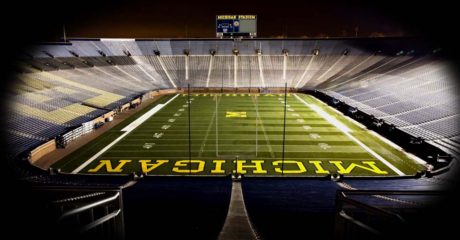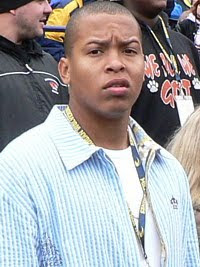 |
| Tom Williams, Yale’s head football coach |
Friday morning we woke up and ate donuts at the clinic. If you didn’t know before, it’s tough to be healthy when you’re a football coach. It was beer and pizza on Thursday, donuts on Friday.
The first session I attended was that of Sean Connors, the quarterbacks coach at Diablo Valley College in California. Connors talked about the pistol offense and, more specifically, the option route. DVC is a junior college with an explosive offense, and the offense is predicated on the option route. If I remember correctly, he said that they run some form of the option route on 52% of their plays.
If you’re wondering, the option route is a play where the slot receiver on either side makes a read at the beginning of his route, deciding whether to run an in route or an out route. The slot receiver tries to get open at six yards (no matter which side he chooses). The outside receiver on the slot’s side must get an outside release and create a deep threat downfield, which hopefully takes the cornerback and/or safety out of the equation. The deep route is obviously a lower percentage pass, but it often comes open because safeties jump the 6-yard route. On the opposite side, the slot receiver and wideout run a “high-low stretch” in which one stays short and the other goes long. It’s not a difficult concept, but it seems like it could be effective with the right personnel. As a junior college, DVC doesn’t get many players who stick around very long, so Connors said that his players can learn it pretty quickly. I’d say it’s working, because I think they averaged 41.3 points per game last year.
The second presentation I attended was Tom Williams, the head coach of Yale. Williams is not exactly what you might expect from an Ivy League head coach. He’s loud and boisterous and a little rough around the edges, but he was very entertaining. I could see why players would want to play for him. He grew up in Forth Worth, TX, and played for both Jack Elway and Bill Walsh at Stanford. He ended up playing a little special teams in the NFL, but ended up coaching shortly thereafter.
Before Williams really started talking about himself, he gave us a history lesson on Yale football. He said that Yale was the first college football team to reach 800 wins. And then the conversation detoured into territory that’s close to my heart. He put up a chart of the teams with the most wins in college football. It went like this:
1. Michigan – 883
2. Yale – 865
He said, “I kinda hoped Rich Rod would stick around a little bit longer. He’s a good guy, though. But Brady Hoke is coming back and gonna bring some tough, hard-nosed, I-formation football.”
I don’t know if Williams has some sort of connection to Michigan, but the talk about the Wolverines didn’t stop there. As the head coach and assistant special teams coach, he talked about how he teaches players to avoid blocks on kickoffs. And regarding avoiding blocks, he said, “Bo Schembechler used to say ‘The issue is the ball.’ Too many guys spend too much time figuring out how to get past blockers. ‘The issue is the ball.'” He repeated that theme several more times. Williams had several interesting drills and techniques to share, but I don’t imagine too many of you are interested in reading about his kickoff drills.
He did, however, reveal the results of an interesting study. When he was an assistant coach with the NFL’s Jacksonville Jaguars, he went back and studied film of all their games. What he wanted to find out was, How important is tackling form? He found a couple of interesting statistics:
- 76% of encounters that involve a tackler making body-to-body contact (in other words, not “arm tackling” but actually having a collision between both torsos) result in tackles
- 70% of encounters that fail to make body-to-body contact (in other words, “arm tackles”) result in missed tackles
Williams had a lot of energy and had film of himself sprinting downfield with his charges on kickoff practice. I thoroughly enjoyed his presentation.
Later, I attended the session by Mike McQueary, the wide receivers coach (and former quarterback) for Penn State. He was five or ten minutes late because he went to the wrong Holiday Inn first. Oops. He shared some insights and film on running screens and draws, but nothing that groundbreaking. I attended the Penn State coaches clinic in 2009 and saw some of the same information about wide receivers that he shared during the second half of his session, so I went to eat lunch instead.
The same afternoon I went to the session of Todd Bradford, who is the new defensive coordinator at Maryland under Randy Edsall. Bradford came from Southern Mississippi this offseason, but he has quite a resume for a little known coordinator. He spent time at Eastern Michigan (where his defense broke a bunch of team records) and Wisconsin (where he coached first rounder Jamar Fletcher), among others. He runs something like a 4-3 Under defense, but it’s extremely complicated. Whereas Sean Connors, the QB coach at Diablo Valley College, used the K.I.S.S. principle (Keep It Simple, Stupid), Bradford’s defense seemed to be extremely complicated. I think it was partially due to his use of jargon, but several coaches that I talked to were confused by some of his terminology and schemes. For example, he would use the phrase “Sam” and “Star” almost interchangeably, and it was unclear if it was something like Greg Robinson’s Sam/Spur position. Eventually, I think I determined that the Star referred to the slot corner that would come into the game in passing situations, but I’m not positive.
Anyway, Bradford had a very interesting approach to defense. He would have his boundary safety (the one to the short side of the field) making adjustment calls literally right up to the snap. But the boundary safety doesn’t communicate to the corners or linebackers – he talks to the defensive linemen. Let’s say the 3-tech defensive tackle has B-gap responsibility and the 5-tech defensive end has C-gap control. If those defensive linemen take their first step and realize that the offensive linemen are trying to reach them (i.e. step outside the defenders to seal the edge), a certain call will tell the 3-tech and the 5-tech to take the gap to the inside so the boundary safety will then have outside contain.
In other words, pre-snap the safety could have A-gap, the DT could have B-gap, and the DE could have C-gap. But if the safety sees something he doesn’t like, he could make a signal for the DT to take A-gap, the DE to take B-gap, and then for himself to take that outside gap. But it all hinges on those defensive linemen immediately reading the block in front of them.
Like I said, it sounds extremely complicated. Maybe that’s one reason why Southern Mississippi finished with the #13 rushing defense in the country in 2010.
 |
| Yes, I know all kinds of people, and I’m not afraid to say it. |
The final speaker of the evening was Kirk Ferentz, Iowa’s head coach. He was both the coach I was most looking forward to seeing . . . and the most disappointing speaker. Maybe he’s genuinely just a very friendly and engaging guy, but if he’s not a “name dropper” then I don’t know who is. Don’t get me wrong – it’s a great quality that he can remember the name of a mother of one of his players back in 1988. Names are difficult to remember, and it shows that he probably listens to people when they talk.
But when you’re sitting in front of a few hundred coaches in Podunk, Pennsylvania, and naming little known players and their mothers from Podunk, Iowa, or Podunk, New Hampshire, then it just seems a little forced.
He did tell an excellent story about some woman’s outstanding recipe for stuffed red bell peppers, so there’s that.
Most of Ferentz’s talk was about the offensive line, which is no surprise, since that’s the position he’s known for developing most. He talked very little about technique, but showed a lot of film. Much of the film was looking at drills, but there was a decent amount of game film, too. Every time a clip of Iowa vs. Michigan would pop up on the screen, my co-workers would look at me consolingly. We all knew that somebody was about to get crushed, and sure enough, there goes Adam Patterson being pushed from his nose tackle position about eight yards downfield and almost to the sideline. There goes Jonas Mouton getting swallowed by a guard. There goes the entire right side of the defense just getting obliterated. It was sad.
Anyway, it’s pretty amazing to hear him talk about where he finds his offensive linemen, because those kids are often virtual nobodies coming out of high school. Michigan fans make a big deal about getting 4- and 5-star recruits, but Ferentz turned two walk-ons – from the same high school, no less! – and turned them into Big Ten starters on a solid team.
Ferentz is also one of those guys who ends his talk about 18 times. “I just want to finish with a couple things” turns into “Before I finish, I just want to say” turns into “There are a couple things I want to leave you with” turns into “And as a side note” turns into “Two things I’d like to share with you are” turns into me wanting to fall asleep. I’m not sure if I would have stayed awake for the entire thing, except for the fact that I was wondering if he would mention anything about Michigan.
He didn’t.
When he was finished, everyone – including Ferentz – went to a separate banquet room, sat around, and drank beer. I sat nowhere near him, but he was there well past midnight.







